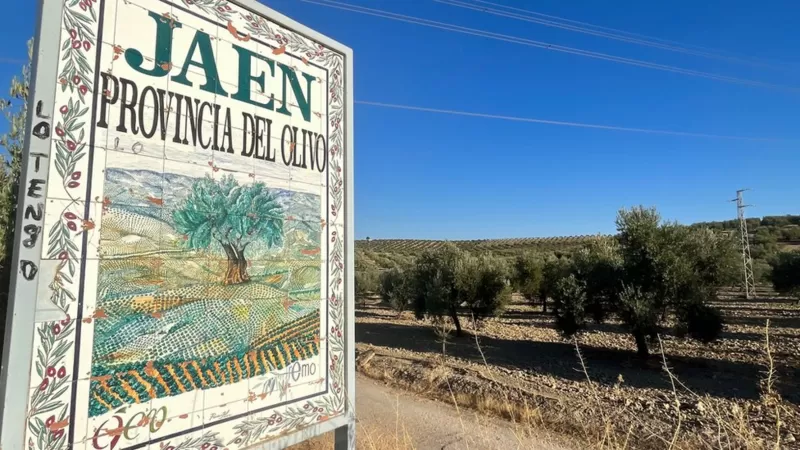- Francisco Elvira picks his way through his scorched olive grove, stopping to inspect the stunted fruit on almost-bare trees.
“Look at them,” he says in desperation. “They ought to be bursting with olives now, close to the harvest. But they’re empty. And this is the crop that should produce the oil in supermarkets next year.”
The fertile plains full of olive trees that stretch across southern Spain have made this country the world’s biggest producer of olive oil, accounting for around half of the global supply.
But devastated by its worst drought ever recorded, Spain’s so-called “green gold” is becoming rarer. This year’s yield is down by around a third already – and there’s still no sign of rain.
At the Interóleo factory in Jaén, a province that generates half of all Spanish oil, pumps spurt it into glass and plastic bottles, which pass along the conveyor belt to be labelled “product of Spain”.
But the plant, which exports to countries including the UK, is seeing production plummet and prices soar, exacerbating the global food crisis.
“Shoppers are already paying a third higher than last year – but the drought will increase that even more,” says Juan Gadeo, the head of the cooperative, who believes this vital sector for Spain is now in danger.
“With the downturn, we may have to lay off some workers. There’s a feeling of depression and uncertainty. Another year like this would be a complete catastrophe.”
It’s a similar picture across the agricultural sector, with recent research finding that parts of the Iberian peninsula are their driest in 1,200 years.
Spanish farmers have been planting more sunflowers since the start of the year, in an attempt to offset the loss of sunflower oil from Ukraine – the world’s largest producer, where the war has led to a drastic drop in production.
But a flower that worships the sun also needs the blessing of rain – and there is none, leading to a mass of shrivelled crops producing neither seeds nor oil.
As she rips up the dead sunflowers from her parched fields, Isabel Villegas contemplates whether to try again.
“If it doesn’t rain by the end of the year, it makes no sense to plant more,” she says. “That would just be like throwing money at the land for no harvest. And there’s no rain forecast for now.”
A recent report by the Global Drought Observatory concluded that Europe is suffering its worst drought in 500 years.
Several countries across the continent have been battling wildfires and heatwaves, with Spain particularly badly hit. More than 270,000 hectares here have been burnt this year, according to the European Forest Fire Information System.
The extreme heat and lack of rainfall have led to a dramatic drop in levels of Spain’s natural water reserves. The Vinuela reservoir near Malaga is at just over 10% of its capacity.
Elsewhere, medieval waterfront villages, long buried beneath rivers, have been exposed as the water evaporates.

The Spanish government is now expanding desalination plants and building new ones, harnessing the ocean to ease the water shortage.
At Campo de Dalias, beside the coastal town of Almeria, we were led down into the cavernous facility where sea water is pumped in.
The salt from half of it is extracted to produce purified water, while the other half absorbs the additional salt and is then siphoned back into the ocean, where it causes no environmental damage.
The plant produces 90,000 cubic metres of clean water each day, but has been ordered to increase to around 130,000 cubic metres within four years.
All around the facility, the fields are full of plastic sheeting, acting as greenhouses for the fruit and vegetables growing beneath.
Half of the water produced in the desalination plant is used to water the crops here. Spain produces more fruit and vegetables than any other country in the European Union.
That, say some scientists, is part of the problem – that in an era of acute water shortage, this country can just no longer afford to be “the garden of Europe”, as it’s often called.
“The total area of irrigated land in Spain has been increasing over the past decades, both legally and illegally,” says Julia Martinez, from the New Water Culture Foundation.
She believes that the country’s current model of water management is unsustainable.
“Irrigated land consumes 85% of all water resources. With the remaining 15%, it is not possible to meet all the remaining water demands, some of which have higher priorities.
Unless we change the balance, we cannot improve the state of our rivers or adapt to climate change.”
Cracked soil, dried-up rivers, withered crops: Spain’s rich land is becoming impoverished by a man-made climate emergency. On our planet and in our pockets, the cost of it is becoming ever starker.
And across the beautiful but parched plains of Andalucia, there is still no rain forecast.
BBC


